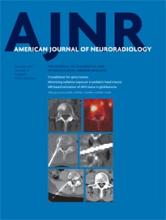Abstract
BACKGROUND AND PURPOSE: Early assessment of treatment response is critical in patients with glioblastomas. A combination of DTI and DSC perfusion imaging parameters was evaluated to distinguish glioblastomas with true progression from mixed response and pseudoprogression.
MATERIALS AND METHODS: Forty-one patients with glioblastomas exhibiting enhancing lesions within 6 months after completion of chemoradiation therapy were retrospectively studied. All patients underwent surgery after MR imaging and were histologically classified as having true progression (>75% tumor), mixed response (25%–75% tumor), or pseudoprogression (<25% tumor). Mean diffusivity, fractional anisotropy, linear anisotropy coefficient, planar anisotropy coefficient, spheric anisotropy coefficient, and maximum relative cerebral blood volume values were measured from the enhancing tissue. A multivariate logistic regression analysis was used to determine the best model for classification of true progression from mixed response or pseudoprogression.
RESULTS: Significantly elevated maximum relative cerebral blood volume, fractional anisotropy, linear anisotropy coefficient, and planar anisotropy coefficient and decreased spheric anisotropy coefficient were observed in true progression compared with pseudoprogression (P < .05). There were also significant differences in maximum relative cerebral blood volume, fractional anisotropy, planar anisotropy coefficient, and spheric anisotropy coefficient measurements between mixed response and true progression groups. The best model to distinguish true progression from non–true progression (pseudoprogression and mixed) consisted of fractional anisotropy, linear anisotropy coefficient, and maximum relative cerebral blood volume, resulting in an area under the curve of 0.905. This model also differentiated true progression from mixed response with an area under the curve of 0.901. A combination of fractional anisotropy and maximum relative cerebral blood volume differentiated pseudoprogression from nonpseudoprogression (true progression and mixed) with an area under the curve of 0.807.
CONCLUSIONS: DTI and DSC perfusion imaging can improve accuracy in assessing treatment response and may aid in individualized treatment of patients with glioblastomas.
ABBREVIATIONS:
- AUC
- area under the curve
- CL
- linear anisotropy coefficient
- CP
- planar anisotropy coefficient
- CS
- spheric anisotropy coefficient
- FA
- fractional anisotropy
- LRM
- logistic regression model
- max
- maximum
- MD
- mean diffusivity
- PsP
- pseudoprogression
- rCBV
- relative cerebral blood volume
- TP
- true progression
- © 2016 by American Journal of Neuroradiology
Indicates open access to non-subscribers at www.ajnr.org












